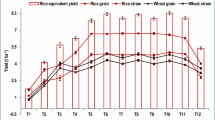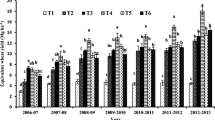Abstract
Given inherent qualities like N-fixation, P-solublization and nutrient recycling pulses remain the most preferred option for diversification of cereal-based rotations. A long-term experiment was used to assess the effect of including pulses in rice–wheat rotation on soil–plant nutrient dynamics under inorganic and organic nutrient management. Results revealed that pulses were equally responsive to organic and inorganic nutrient management while, growth of cereals especially wheat was restricted severely under organic production system due to low nutrient input. The annual input (kg ha−1) of N (103.6–160.8) and P (25.9–34.7) under organic treatment was almost ½ of the recommended inorganic rate, while organics supplied higher K and S. Under organic management, the apparent balance of all the nutrients was negative whereas, inorganic fertilization resulted in positive balance of N, P and Zn. Long-term inclusion of pulses in rice–wheat rotation significantly increased soil organic C and available nutrients thus, increased the nutrient uptake by cereals. Mungbean inclusion in rice–wheat rotation significantly (P ≤ 0.05) increased uptake of N (23.0 %), P (32.9 %) and K (21.1 %) by rice crop. Continuous inorganic fertilization enriched soil available N, P, Zn and B. While organic management maintained higher SOC, available K and S over inorganic treatment. Thus, the study suggested that under organic management N and P nutrition is limiting factor for cereals and needs inorganic supplementation. The study also indicates the need for including pulses in conventional rice–wheat system for optimum nutrient acquisition and long-term soil health management.



Similar content being viewed by others
References
Ahlawat IPS, Ali M, Yadav RL, Kumar Rao JVDK, Rego TJ, Singh RP (1998) Biological nitrogen fixation and residual effects of summer and rainy season grain legumes in rice and wheat cropping systems of the Indo-Gangetic plain. In: Kumar Rao JVDK, Johansen C, Rego TJ (eds) Residual effects of legumes in rice and wheat cropping systems of the Indo-Gangetic plain. Oxford & IBH Publishing Co. Pvt. Ltd. and ICRISAT, New Delhi and Pantancheru, India, pp 31–54
Aulakh MS, Kabba BS, Baddesha HS, Bahl GS, Gill MPS (2003) Crop yields and phosphorus fertilizer transformations after 25 years of applications to a subtropical soil under groundnut based cropping systems. Field Crops Res 83:283–296
Bajwa ML (1994) Soil potassium status, potash fertilizer usage and recommendations in Pakistan. Potash Review No. 3. International Potash Research Institute, Basel
Becker M, Ladha JK, Ali M (1995) Green manure technology: potential, usage, and limitations–a case study for lowland rice. Plant Soil 174:181–194
Berry PM, Sylvester-Bradley R, Philipps L, Hatch DJ, Cuttle SP, Rayns FW, Gosling P (2002) Is the productivity of organic farms restricted by the supply of available nitrogen? Soil Use Manag 18:248–255
Bhandari AL, Ladha JK, Pathak H, Padre AT, Dawe D, Gupta RK (2002) Yield and soil nutrient changes in a long-term rice-wheat rotation in India. Soil Sci Soc Am J 66:162–170
Singh Y, Singh B, Ladha JK, Khind CS, Khera TS, Bueno CS (2004) Effects of residue decomposition on productivity and soil fertility in rice–wheat rotation. Soil Soil Sci Soc Am J 68:854–864
Buresh RJ, De Datta SK (1991) Nitrogen dynamics and management in rice-legume cropping systems. Adv Agron 45:1–59
Burgess MS, Mehuys GR, Madramootoo CA (2002) Decomposition of grain-corn residues (Zea mays): a litter bag study under three tillage systems. Can J Soil Sci 82:127–138
Chan KY, Bowman A, Oates A (2001) Oxidizible organic carbon fractions and soil quality changes in oxicpaleustalf under different pasture leys. Soil Sci 166:61–67
Chatterjee BN, Mondal SS (1996) Potassium nutrition under intensive cropping. J Potassium Res 12:358–364
De Datta SK, Mikkelsen DS (1985) Potassium nutrition of rice potassium in agriculture. In: Munson RD (eds) Potassium in agriculture, ISBN: 978-0-89118-247-4. Chapter 30, pp 665–699
Ganeshamurthy AN (2009) Soil changes following long-term cultivation of pulses. J Agric Sci 147:699–706
Ghosh PK, Sharma KC (1996) Direct and residual effect of green manuring in rice-wheat rotation. Crop Res 1(2):133–136
Ghosh PK, Mohanty M, Bandyopadhyay KK, Painuli DK, Misra AK (2006) Growth, competition, yields advantage and economics in soybean/pigeonpea intercropping system in semi-arid tropics of India: II. Effect of nutrient management. Field Crop Res 96(1):90–97
Ghosh PK, Venkatesh MS, Hazra KK, Kumar N (2012) Long-term effect of pulses and nutrient management on soil organic carbon dynamics and sustainability on an Inceptisol of Indo-Gangetic plain of India. Exp Agric 48:473–487
Glendining MJ, Powlson DS, Poulton PR, Bradbury NJ, Palazzo D, Ll X (1996) The effects of long-term applications of inorganic nitrogen fertilizer on soil nitrogen in the Broadbalk Wheat Experiment. J Agric Sci 127(03):347–363
Goswami NN, Prasad R, Sarkar MC, Singh S (1988) Studies on the effect of green manuring in nitrogen economy in a rice-wheat rotation using a 15N technique. J Agric Sci 111:413–417
Green CJ, Blackmer AM, Horton R (1995) Nitrogen effects on conservation of carbon during corn residue decomposition in soil. Soil Sci Soc Am J 59:453–459
Guo F, Yost RS, Hue NV, Evensen CI, Silva JA (2000) Changes in phosphorus fractions in soils under intensive plant growth. Soil Sci Soc Am J 64:1681–1689
Hossain MdI (2009) Nutrient and residue management for improving productivity and N use efficiency of rice-wheat-mungbean systems in Bangladesh. In: The proceedings of the international plant nutrition colloquium XVI, Department of Plant Sciences, UC Davis
Islam M, Ali S, Mohsan S, Khalid R, Fayyaz-ul-Hassan, Mahmood A, Afzal S (2012) Relative efficiency of two sulfur sources regarding nitrogen fixation and yield of chickpea. Comm Soil Sci Plant Anal 43(5):811–820
Jackson ML (1973) Soil chemical analysis. Prentice Hall—of India (Pvt.) Ltd., New Delhi
Janzen HH (1987) Effect of fertilizer on soil productivity in long-term spring wheat rotations. Can J Soil Sci 67:165–174
Kumar N, Mina BL, Chandra S, Srivastva AK (2011) In-situ green manuring for enhancing productivity, profitability and sustainability of upland rice. Nutr Cycl Agroecosyst 90(3):369–377
Ladha JK, Dawas D, Pathak H, Padre AT, Yadav RL, Singh B (2003) How extensive are yield decline in long-term rice-wheat experiments in Asia. Field Crop Res 81:159–180
LaRue TA, Patterson TG (1981) How much nitrogen do legumes fix. Adv Agron 34:15–38
Lauren JG, Duxbury JM, Beri V, Razzaque II MA, Sattar MA, Pandey SP, Bhattarai S, Mann RA, Ladha JK (1998) Direct and residual effects from forage and green manure legumes in rice-based cropping systems. In: Kumar Rao JVDK, Johansen C, Rego TJ (eds) Residual effects of legumes in rice and wheat cropping systems of the Indo-Gangetic plain, Oxford & IBH Publishing Co. Pvt. Ltd. and ICRISAT, New Delhi and Pantancheru, India, pp 55–81
Majumder B, Mandal B, Bandyopadhyay PK, Chaudhury J (2007) Soil organic carbon pools and productivity relationships for a 34 year old rice–wheat–jute agro-ecosystem under different fertilizer treatments. Plant Soil 297(1–2):53–67
Mubarak AR, Rosenani AB, Anuar AR, Zauyah S (2002) Decomposition and nutrient release of maize stover and groundnut haulm under tropical field conditions of Malaysia. Comm Soil Sci Plant Anal 33:609–622
Mukherjee D, Chattopadhyay MK, Chakravarty A (1995) Some aspects of chemical changes as influenced by different organic additives in Entisols of Gangetic origin. Adv Plant Sci 8:169–176
Nandwa SM, Bationo A, Obanyi SN, Rao IM, Sanginga N, Vanlauwe B (2011) Inter and intra-specific variation of legumes and mechanisms to access and adapt to less available soil phosphorus and rock phosphate (Chapter 3). In: Bationo A, Waswa B, Okeyo JM, Maina F, Kihara J, Mokwunye U (eds) Fighting poverty in sub-Saharan Africa: the multiple roles of legumes in integrated soil fertility management
NREL (2003) Biomass feedstock composition and properties database. http://www.ott.doe.gov/biofuels/properties_database.html
Patil MN, Zade KB, Naphade KT, Kharkar PT (1993) Decomposition of organic materials in soil in relation to nutrient mineralization. J Maharastra Agric Univ 18:348–351
Peoples MB, Craswell ET (1992) Biological nitrogen fixation: investments, expectations and actual contributions to agriculture. Plant Soil 141:13–39
Rekhi RS, Bajwa MS (1993) Effect of green manure on the yield, N uptake and floodwater properties of a flooded rice, wheat rotation receiving 15 N urea on a highly permeable soil. Fert Res 34:15–22
Saraf CS, Patil RR (1995) Fertilizer use in pulse based cropping systems. Fert News 40(5):55–65
Saraf CS, Rupela OP, Hegde DM, Yadav RL, Shivakumar BG, Bhattarai S, Razzaque II MA, Sattar MA (1998) Biological nitrogen fixation and residual effects of winter grain legumes in rice and wheat cropping systems of the Indo-Gangetic plain. In: Kumar Rao JVDK, Johansen C, Rego TJ (eds) Residual effects of legumes in rice and wheat cropping systems of the Indo-Gangetic plain. Oxford & IBH Publishing Co. Pvt. Ltd. and ICRISAT, New Delhi and Pantancheru, India, pp 55–81
Sarkar S, Rathore TR, Sachan RS, Ghildyal BP (1989) Effect of wheat straw management on cation status of Tarai soils. J Indian Soc Soil Sci 37:402–404
Schillinger WF (2010) Practical lessons for successful long-term cropping systems experiments. Renew Agric Food Syst 26(1):1–3
Timsina J, Connor DJ (2001) Productivity and management of rice-wheat cropping systems: Issues and challenges. Field Crop Res 69:93–132
Venkatesh MS, Hazra KK, Ghosh PK, Praharaj CS, Kumar N (2013) Long-term effect of pulses and nutrient management on soil carbon sequestration in Indo-Gangetic plains of India. Can J Soil Sci 93(1):127–136
Ventura W, Watanabe I, Komada H (1984) Soil sickness caused by continuous cropping of upland rice, mungbean, and other crops [maize and sorghum; Philippines] 99: 13
Walkley A, Black IA (1934) An examination of method for determining organic carbon in soils: effect of variations in digestion conditions and of inorganic soil constituents. Soil Sci 63:251–263
Watson CA, Bengtsson H, Løes AK, Myrbeck A, Salomon E, Schroder J, Stockdale EA (2002) A review of farm-scale nutrient budgets for organic farms in temperate regions. Soil Use Manag 18(s1):264–273
Wolf B (1982) The comprehensive system of leaf analysis and its use for diagnosing crop nutrient status. Comm Soil Sci Plant Anal 13:1035–1059
Yadav RL, Dwivedi BS, Prasad K, Tomar OK, Shurpali NJ, Pandey PS (2000) Yield Trend and changes in soil organic C and available NPK in long-term rice-wheat system under integrated use of manure and fertilizer. Field crop Res 68:219–246
Singh Y, Singh B, Timsina J (2005) Crop residue management for nutrient cycling and improving soil productivity in rice-based cropping systems in the tropics. Adv Agron 85:269–407
Author information
Authors and Affiliations
Corresponding author
Rights and permissions
About this article
Cite this article
Hazra, K.K., Venkatesh, M.S., Ghosh, P.K. et al. Long-term effect of pulse crops inclusion on soil–plant nutrient dynamics in puddled rice (Oryza sativa L.)-wheat (Triticum aestivum L.) cropping system on an Inceptisol of Indo-Gangetic plain zone of India. Nutr Cycl Agroecosyst 100, 95–110 (2014). https://doi.org/10.1007/s10705-014-9629-6
Received:
Accepted:
Published:
Issue Date:
DOI: https://doi.org/10.1007/s10705-014-9629-6




